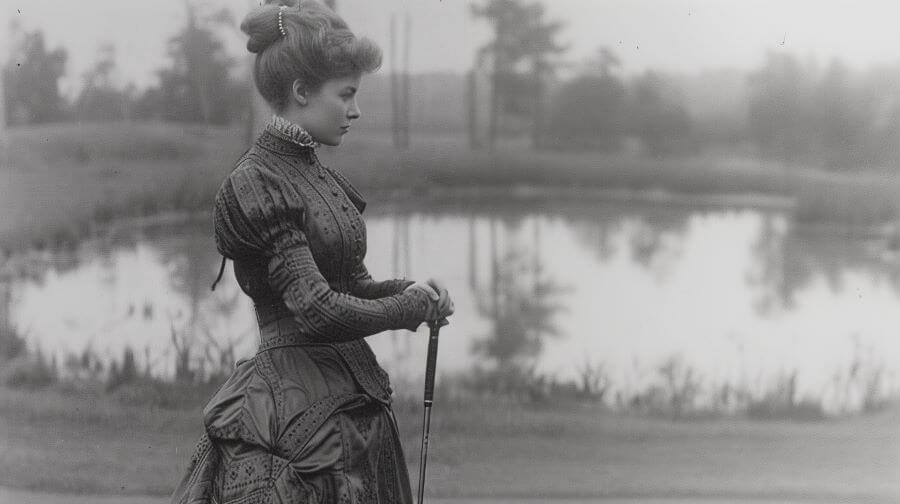Breaking Barriers: Women in the World of Golf
The landscape of golf has undergone significant transformation over the years, evolving from a sport once bound by rigid gender norms into a more inclusive field where women’s contributions are increasingly recognized and celebrated.
This shift has not been without its challenges, as women have had to navigate the fairways of prejudice and the bunkers of institutional barriers to secure their rightful place on the course.
The journey of women in golf is emblematic of a broader struggle for equality, reflecting the tenacity required to break through the deeply entrenched traditions of a centuries-old sport.
As we consider the strides made by female golfers, the question arises: what hurdles remain, and what new chapters are yet to be written in the ongoing narrative of women’s golf?
The answer lies in understanding the past triumphs and the current state of play, which may provide a glimpse into an even more equitable future for the sport. With womens golf holidays on the rise, we are on the way up.
Pioneers of Women’s Golf
While the fairways of golf have traditionally been dominated by men, pioneering women have driven from the tee of history to shape a more inclusive game, breaking down the gender barriers that once confined them to the clubhouse.
The greens and bunkers of the world’s courses have witnessed the emergence of female golfers who, with every swing, challenge the status quo and carve their place in the annals of golf history. Women players, once marginalized, now stand as titans of talent and determination, inspiring new generations to grip their clubs with confidence and ambition.
The establishment of the LPGA Tour was a watershed moment, a testament to the indefatigable spirit of women pioneers in golf. This premier circuit not only provided a platform for competitive play but also symbolized a cultural shift towards acknowledging and celebrating the skill of women golfers.
The LPGA Tour’s existence enshrined the contributions of these trailblazers and set the stage for monumental events that would highlight women’s prowess on the course. Through their legacy, women’s participation in golf events has grown, fostering a sense of belonging and camaraderie among players and fans alike, and ensuring that the game’s future is as vibrant and inclusive as the visions of its pioneers.
Gender Disparities in Golf
Despite the trailblazing efforts of early female golfers and the establishment of the LPGA, enduring gender disparities in golf highlight a complex fairway still to be navigated. Women have made undeniable strides on the greens and fairways of golf courses worldwide. Yet, they continue to confront obstacles that range from unequal tournament prize money to disproportionate opportunities in playing significant events on the PGA Tour.
Analysing the distribution of resources and recognition reveals that gender disparities persist in the heart of this community. The iconic 18 holes of Augusta National, for instance, only recently opened its clubs to women members, reflecting broader patterns of exclusion and belated acceptance. On the professional circuit, female players often vie for visibility and sponsorship, with media coverage lagging behind their male counterparts.
However, the winds of change are stirring. Women’s golf is gaining momentum, with the community rallying behind players who challenge the status quo. Tournaments like the Women’s PGA Championship showcase the prowess of female golfers, promising a future where the landscape of golf is as inclusive as it is competitive. The drive for equity is a shared mission, and with each swing, women in golf are reshaping not just the game but the culture surrounding it.
There are some famous female golfers of course. Annika Sörenstam is considered one of the greatest female golfers of all time, Sörenstam has won 72 LPGA Tour events, including 10 major championships.
Patty Berg won 15 major championships and helped found the LPGA Tour. Babe Didrikson Zaharias won 41 LPGA Tour events and 10 major championships. Nancy Lopez is one of the most popular players in women’s golf history, winning 48 LPGA Tour events, including three major championships. Mickey Wright won 82 LPGA Tour events, including 13 major championships.
And Lorena Ochoa, Karrie Webb, Laura Davies, Inbee Park, and Lydia Ko all deserve a mention.
Landmark Achievements Unveiled
The realm of golf has witnessed a series of landmark achievements by women, marking significant milestones in the sport’s journey towards gender equality. Historical figures such as Mary Queen of Scots, the ‘Mother of Golf,’ set the precedent for women on the golf course, challenging the status quo and inspiring future generations.
Milestone events like the establishment of the Ladies Professional Golf Association (LPGA) by trailblazers including Helen Kicks Harb and Babe Zaharias have been instrumental in solidifying women’s place in the sport. Their efforts paved the way for others like Annika Sörenstam, whose 97 professional wins epitomize the heights of success that women can achieve in golf.
These achievements are not just historical footnotes but are the bedrock upon which the current progress is built. Women’s increasing membership and participation in golf clubs around the world are testimonies to the crumbling barriers once thought insurmountable.
Each swing, each tournament victory, and each induction into halls of fame are not just personal triumphs but collective leaps toward a future where equality is the norm on every golf course. This ongoing transformation serves as a rallying call for those who desire belonging in the golf community, affirming that the fairway is open to all who love the game.
The LPGA’s Impact
Since its inception in 1950, the Ladies Professional Golf Association (LPGA) has played a crucial role in transforming the landscape of women’s golf, both by elevating the game’s profile and by fostering equal opportunities for women in the sport. Through its efforts, the LPGA has systematically dismantled barriers that once kept women on the fringes of the golf club scene. The organization’s impact resonates not just within its growing membership, but across the entire sphere of professional sports.
The LPGA has been instrumental in organizing events that showcase the extraordinary talents of women golfers, ensuring they compete at the highest level and receive recognition comparable to their male counterparts. These tournaments not only highlight the skill and tenacity of LPGA members but also inspire countless women and girls to pursue their passion for golf. The sport’s par is no longer defined by gender but by the ability and achievements of the players.
Global Growth of Women’s Golf
Women’s golf has witnessed a remarkable expansion on a global scale, with more female athletes participating and succeeding in international tournaments than ever before. This growth transcends mere numbers; it reflects a broader cultural shift where barriers are being dismantled and access to golf courses is increasingly democratized. Women players are not only welcomed but celebrated, inspiring a surge in participation across diverse demographics.
The proliferation of events tailored to women golfers has played a pivotal role in this ascendancy. Each tournament serves as a platform for skilful display and an avenue for networking and camaraderie, fostering a community that thrives on mutual support and empowerment. Moreover, the increase in global events has highlighted the universal appeal of golf, uniting players from various backgrounds in their shared passion for the sport.
As the landscape of women’s golf evolves, the growth is palpable. Courses once exclusive are opening their gates, and the number of women wielding clubs is surging. This is a testament to the resilience of women who have long aspired to make their mark on the fairways and greens of this historic game.
The future of women’s golf shines bright, promising an enduring legacy and an inclusive horizon for the sport.
Golf’s Gender Pay Gap
How does the persistent gender pay gap in professional golf reflect broader societal inequities, despite the sport’s progress in gender inclusivity?
The stark contrast in earnings between male and female professional golfers is not merely a disparity within the sport but also a mirror of entrenched gender biases that permeate various sectors. Women in golf have indeed shattered numerous barriers, yet the monetary recognition of their achievements remains significantly distant from that of their male counterparts.
The gender pay gap in golf is emblematic of the broader challenges women face in the pursuit of equality. While the LPGA has made strides, the discrepancy in prize money—when compared to the PGA—is a clear indicator of the undervaluing of women’s contributions. This gap not only affects the earnings of current players but also impacts the aspirations of future generations, potentially discouraging young women from considering professional golf as a viable career.
Addressing this pay gap requires a collective effort to recalibrate the financial structures and cultural perceptions that dictate value in the sport. As the barriers of gender inequality continue to be challenged both on and off the greens, the ultimate goal is to reach a level where women’s golf is not seen through the lens of gender but celebrated for the skill and excellence it undoubtedly exhibits.
Breaking Through the Grass Ceiling
Despite historical challenges and societal barriers, female golfers are increasingly ‘breaking through the grass ceiling,’ demonstrating remarkable achievements and changing the face of the sport. The term ‘grass ceiling’—a play on the corporate world’s ‘glass ceiling’—aptly describes the invisible yet tough barriers that women in golf have faced. It’s a testament to their perseverance and skill that we now see a transformative era where women are not just participants but influential members of the golfing world.
The presence of women in golf has evolved from the days of pioneers like Mary Queen of Scots to modern icons such as Annika Sörenstam, whose experience and success have inspired countless others. Women’s contributions are not confined to the course; they are integral to the sport’s community, enhancing the global golf experience with diverse perspectives and styles.
Breaking into this traditionally male-dominated club required resilience and determination. As barriers fall, the world witnesses the emergence of more inclusive golf clubs and organizations keen on supporting women golfers. These changes signify a broader cultural shift, where the skills and accomplishments of female golfers are celebrated, encouraging a new generation to take up the sport and break their own barriers.
Media Representation and Sponsorships
As female golfers shatter the ‘grass ceiling’ with their athletic prowess, enhanced media representation and increased sponsorship deals are pivotal in elevating their visibility and commercial success in the sport.
The journey of women in golf, from early pioneers like Babe Zaharias to contemporary icons like Annika Sörenstam, reflects a trajectory of overcoming barriers and claiming space in a traditionally male-dominated arena.
Today, the media is taking note, with more airtime and coverage dedicated to women’s events, showcasing the skill and competitiveness of the players.
Moreover, sponsorships are a vital lifeline, supplying not just financial support but also a sense of belonging and recognition for women golfers. These deals often extend beyond the fairways, as athletes become ambassadors for a diverse range of products and brands.
Companies are increasingly keen to align with the values and stories these women represent, understanding the power of inclusivity and the changing group dynamics within the sport’s audience.
The symbiotic relationship between media representation and sponsorships forms a reinforcing cycle that propels women golfers forward. As every event covered and every team or individual sponsored amplifies their achievements, it sends a clear message: women golfers are here, excelling, and reshaping the landscape of golf.
Future Stars on the Horizon
The emergence of talented young golfers promises to redefine the future landscape of women’s golf with their remarkable skills and fresh perspectives. As the sport evolves, these rising stars bring a dynamic range of shots and a fearless approach to play that captivates audiences and inspires a new generation. These athletes are not just playing rounds of golf; they are redefining the very fabric of the game, from the greens to the clubhouse.
Each hole on the course is an opportunity for these young women to demonstrate their prowess and add their names to the prestigious list of golfing legends. With every tournament, they showcase their ability to navigate the complexities of the course, offering a masterclass in precision and strategy. The details of their technique and the power of their swings are dissected by people who follow the sport, highlighting the depth of talent in this area.
Inclusion within the golfing community is paramount, and these future stars embody the dreams and aspirations of many young women. They are not just playing for themselves but for every girl who has been told that golf is not their game. As barriers continue to fall, the greens become a stage for excellence and empowerment, making every round a testament to progress and possibility.
Cultivating Inclusivity on the Green
Building on the momentum of emerging young talent, golf is increasingly embracing diversity and fostering an environment where players of all backgrounds feel welcomed and valued. The green, once a place of exclusivity, now cultivates a spirit of inclusivity, becoming a canvas where every stroke and every player contributes to a richer tapestry of the game.
This transformation is not the work of one individual but a collective effort. Iconic names in women’s golf, such as Annika Sörenstam and Babe Zaharias, have paved fairways for a future where gender is no barrier to entry. The LPGA and other organizations have taken firm steps in ensuring that all individuals, regardless of their gender, race, or socioeconomic status, are part of the global golfing family.
Inclusivity extends beyond the mere presence on the course; it is about fostering a culture where things like mentorship, access to resources, and positive representation are commonplace. The dialogue has shifted to one that values diverse views, recognizing that everyone has a part to play in the game’s evolution.
As such, the green is no longer just a playing field—it is a symbol of unity, a place where the love for golf transcends differences, inviting a world of players to share in the beauty of the game.
Conclusion
In conclusion, the relentless pursuit of equality by women in golf has significantly altered the landscape of the sport. Landmark achievements have not only underscored the prowess of female golfers but have also catalysed global participation and recognition.
The continued expansion of the LPGA and strategic media partnerships have been pivotal in enhancing visibility and inclusivity. As the green fosters new talent, the enduring legacy of these pioneering women propels the momentum towards a more equitable future in golf.







